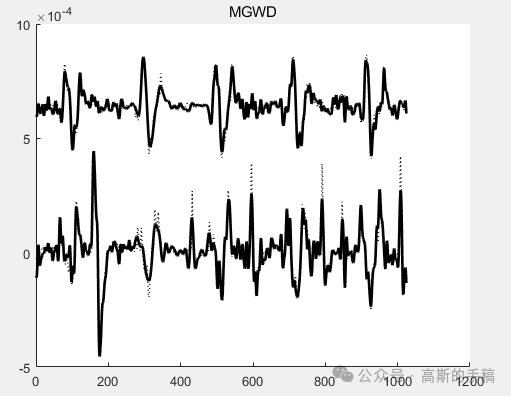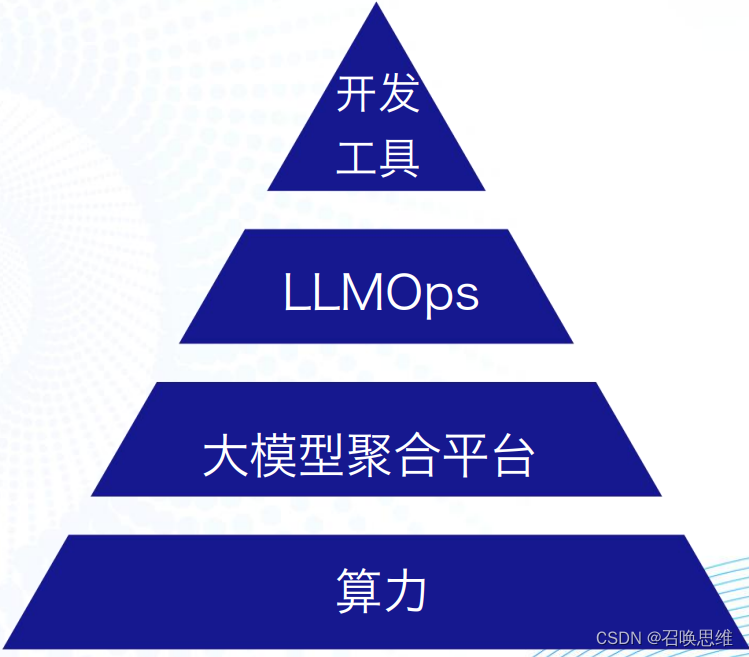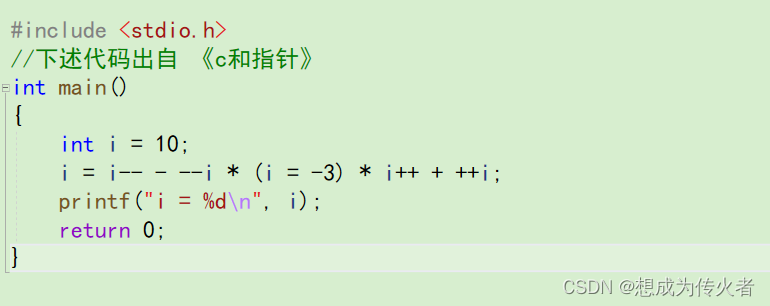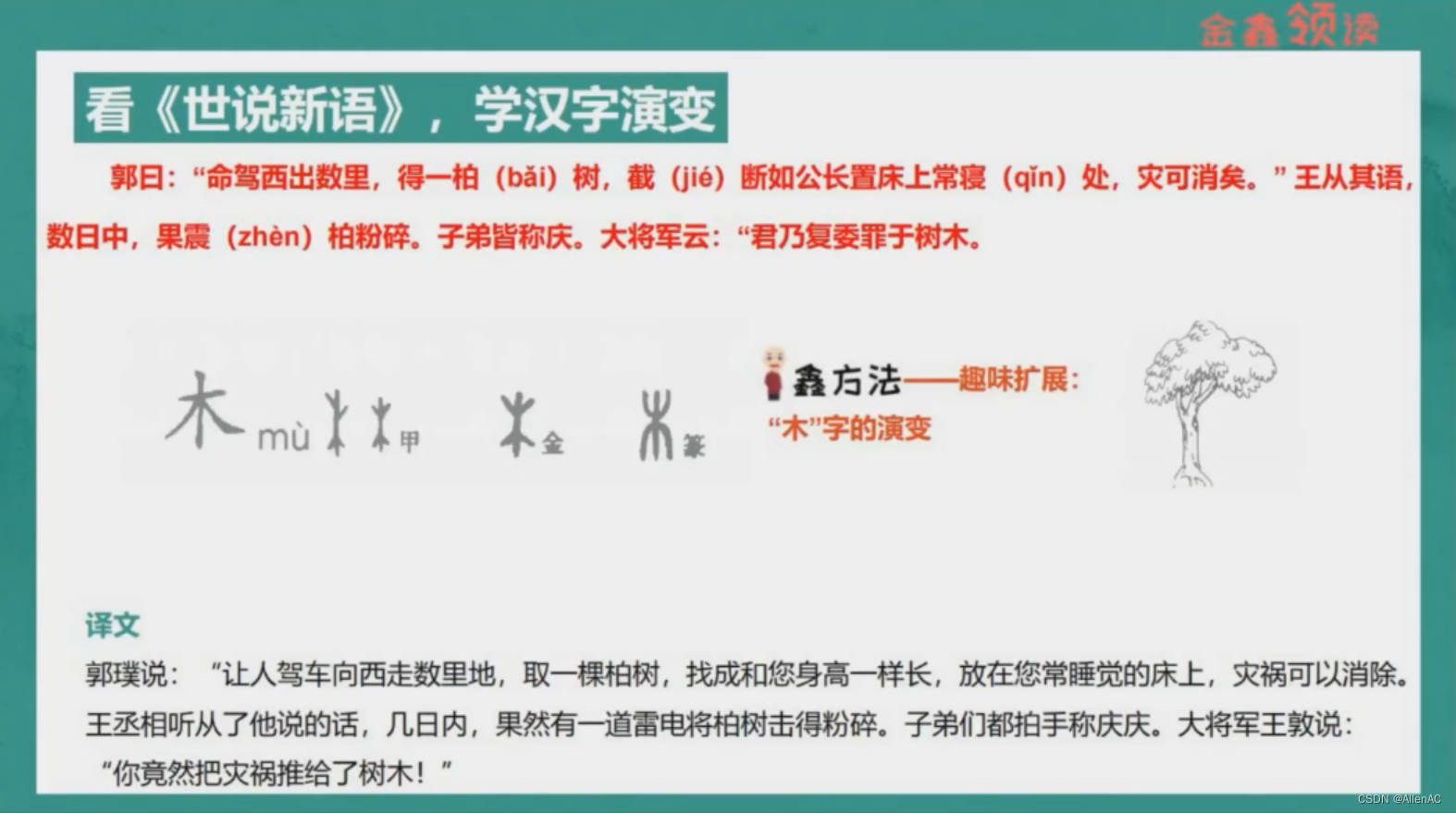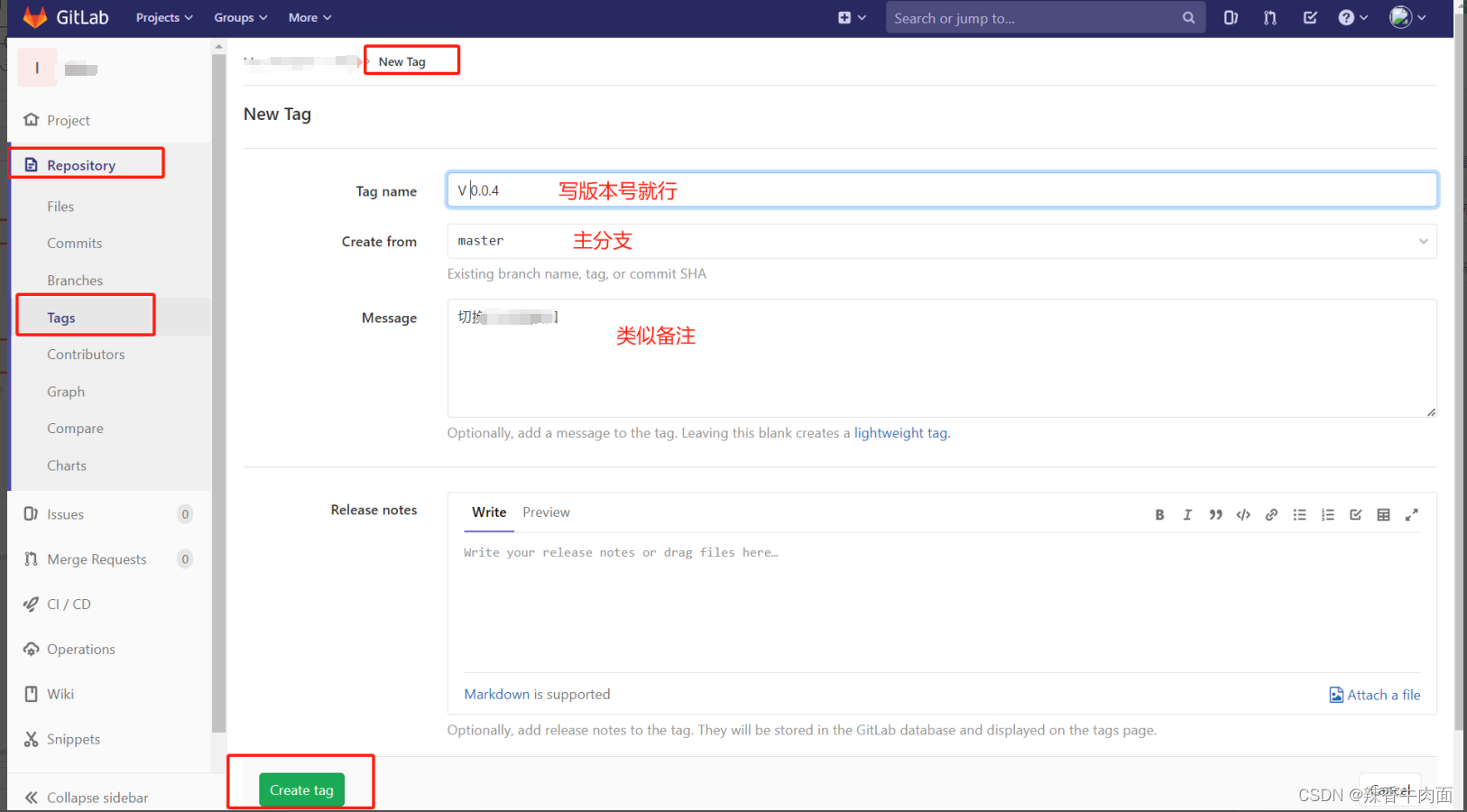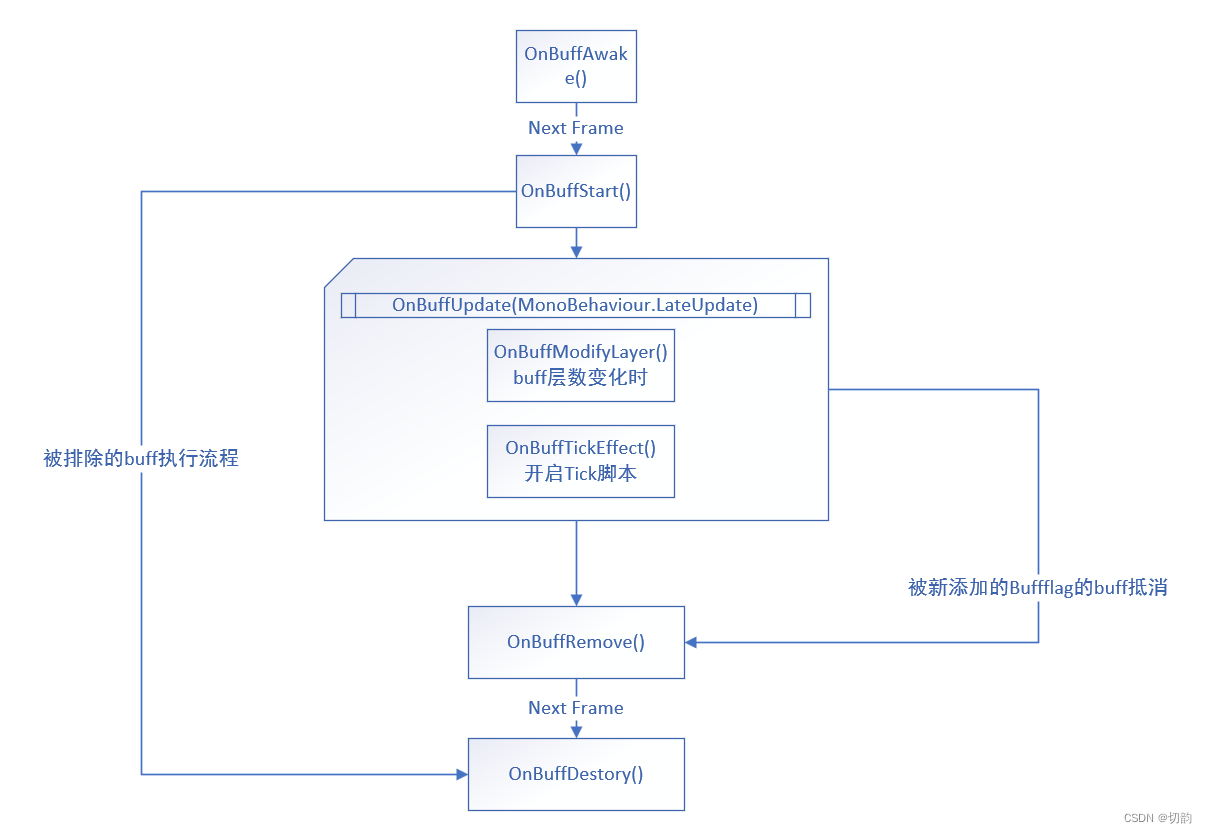文章目录
- 概述
- 目标
- FASTAPI 介绍
- CRUD API
- 项目设置
- freeze
- pipreqs
- 代码介绍
- run API
- pytest测试
- conftest
- 测试用例
- 测试报告
- F&Q
- 1.执行uvicorn app.main:app --host localhost --port 8000 --reload 报错 zsh: /usr/local/bin/uvicorn: bad interpreter
- 2.生成requirement.txt时,pip3 list pipreqs有,但是执行pipreqs提示command not found
- ~/.bash_profile
- ~/.zshrc
- 3.pydantic_core._pydantic_core.ValidationError: 1 validation error for UserBaseSchema
概述
API是连接前后端的前梁,当然前端既可以是UI web的前端,也可以是client端,API的测试和构建一样重要。
FastAPI 是一个用python构建API非常不错的框架,如何确保在客户端或服务器发生错误时 API 返回有用的响应?您应该针对真实数据进行测试还是模拟测试?
在本文中,介绍构建增删改查API(增加(Create)、检索(Retrieve)、更新(Update)和删除(Delete))使用**FastAPI**、SQLite并使用fixture等对pytest进行测试。
这里介绍构建Rest API - 从数据库创建、读取、更新、删除用户。
目标
结合本文,从以下几个方面介绍
- 开发一个增删改查使用FastAPI框架在Python中实现Rest API
- 使用SQLAIchemy ORM 工具和SQLite数据库交互
- 使用pytest为FastAPI 进行单测
- 处理错误和响应
- 使用 FastAPI 的内置Swagger 记录REST API
对于API这里不在赘述,我们了解下FastAPI
FASTAPI 介绍
FastAPI是一个高性能的python web框架,可以轻松构建 API,最初由Sebastian Ramirez于18年创建,并在2019年发布。它是建立在Python 库之上:Starlette和Pydantic,其中Starlette 是提供底层 Web 应用程序框架,而 Pydantic 是用于数据验证和序列化的库。FastAPI的设计注重易用性,和性能,同时还内置了async/await的支持,使其比传统的同步线程模型更高效。
CRUD API
它是包括了HTTP方法(POST、GET、PUT、DELETE)的设计原则,用于对数据库DB系统中的数据维护的基本操作。广泛用于 Web 开发,用于实现内容管理和维护
项目设置
项目中,我们创建一个增删改查使用API从的关系型数据库(使用SQLite)创建、读取、更新和删除用户,项目名称这里叫fastapi_curdapi
fastapi_curdapi
├── app
│ ├── __init__.py
│ ├── database.py
│ ├── main.py
│ ├── models.py
│ ├── schemas.py
│ └── user.py
├── pyest.ini
├── pyproject.toml
├── requirements.txt
├── tests
│ ├── __init__.py
│ ├── conftest.py
│ └── test_curd_api.py
其中app目录下包含源代码如下所示:
- database.py — 创建数据库引擎和 SQLite 设置。
- main.py — 创建 FastAPI 客户端、健康检查器和中间件。
- models.py - 数据库架构。
- schemas.py — 用户基础架构和响应架构。
- user.py — API 路由和响应格式。
- tests目录包含 API 的单元测试。
文件中列出了依赖项 pyproject.toml,或者说使用requirement.txt 这里使用pip3进行维护
fastapi==0.111.0
pydantic==2.7.3
SQLAlchemy==2.0.30
SQLAlchemy_Utils==0.41.2
对于项目生成requirement.txt,常用有两种方法
freeze
- 应用场景:在单一虚拟环境下,可以使用这种方式。
- 优点:这种方式会把当前环境下的所有依赖包都整理出来。
- 缺点:不是针对某个项目生成,如果当前环境下有多个项目,那么会生成大量无关的依赖信息。
pip freeze > requirements.txt
- 但是用这个方法,可以实现一个功能:删除当前环境的所有python依赖。
pip uninstall -r requirements.txt -y
pipreqs
- 应用场景:针对单个项目生成 requirements.txt
- 优点:使用 pipreqs 可以自动检索到当前项目下的所有组件及其版本,并生成 requirements.txt 文件,极大方便了项目迁移和部署的包管理。
- 缺点:相比直接用 freeze 命令,能直接隔离其它项目的包生成。
pipreqs ./ --encoding=utf-8
#强制执行命令 --force ,覆盖原有的 requirements.txt 文件
pipreqs ./ --encoding=utf-8 --force
所以这里使用pipreqps
代码介绍
database.py是创建数据库引擎和SQLite设置的代码
#!/usr/bin/env python
# -*- coding: utf-8 -*-
# This module is ***
# @Time : 2024/6/6 09:54
# @Author :
# function :
# @File : database.py
from sqlalchemy import create_engine
# from sqlalchemy.ext.declarative import declarative_base
# 解决如下告警:
""" MovedIn20Warning: The ``declarative_base()`` function is now available as sqlalchemy.orm.declarative_base(). (deprecated since: 2.0) (Background on SQLAlchemy 2.0 at: https://sqlalche.me/e/b8d9)
Base = declarative_base()
"""
from sqlalchemy.orm import declarative_base
from sqlalchemy.orm import sessionmaker
SQLITE_DATABASE_URL = "sqlite:///./user.db"
# 创建一个 SQLite 的内存数据库,必须加上 check_same_thread=False,否则无法在多线程中使用
engine = create_engine(
SQLITE_DATABASE_URL, echo=True, connect_args={"check_same_thread": False}
)
# 创建DBSession类型sessionmaker 是 SQLAlchemy 中的一个工厂类,用于创建 Session 对象。Session 对象是与数据库进行交互的会话,它提供了一系列方法来执行数据库操作,例如查询、插入、更新和删除数据。
# 通过使用 sessionmaker,可以方便地创建和管理 Session 对象,而无需每次都手动创建。sessionmaker 通常与数据库引擎(Engine)一起使用,以便为 Session 对象提供数据库连接。而且因为Session不是线程
# 安全的,一般web框架应该在每个请求开始获取一个session,这样使用sessionmaker创建工厂函数,就不用没
SessionLocal = sessionmaker(autocommit=False, autoflush=False, bind=engine)
# 创建对象的基类
Base = declarative_base()
def get_db():
db = SessionLocal()
try:
yield db
finally:
db.close()
SQLite作为内存数据库,使用起来较为简便,当然还可以使用PostgreSQL、MySQL等数据库。而get_db函数是一个依赖项,将会为注入的每个请求创建一个新的数据库会话session。这里给出v1版本的warning及解决方法
models.py-数据库架构
#!/usr/bin/env python
# -*- coding: utf-8 -*-
# This module is ***
# @Time : 2024/6/6 09:54
# @Author :
# function :
# @File : models.py
from app.database import Base
from sqlalchemy import TIMESTAMP, Column, String, Boolean
from sqlalchemy.sql import func
from sqlalchemy_utils import UUIDType
import uuid
class User(Base):
# 使用__tablename__指定数据库表名
__tablename__ = "users"
# Primary key and GUID type
id = Column(UUIDType(binary=False), primary_key=True, default=uuid.uuid4)
# String types with appropriate non-null constraints
first_name = Column(
String(255), nullable=False, index=True
) # Indexed for faster searches
last_name = Column(
String(255), nullable=False, index=True
) # Indexed for faster searches
address = Column(String(255), nullable=True)
# Boolean type with a default value
activated = Column(Boolean, nullable=False, default=True)
# Timestamps with timezone support
createdAt = Column(
TIMESTAMP(timezone=True), nullable=False, server_default=func.now()
)
updatedAt = Column(TIMESTAMP(timezone=True), default=None, onupdate=func.now())
本例中的数据模型非常简单 - 一个包含列的User表- id、first_name、last_name、address、activated、createdAt、updatedAt
使用SQLAlchemy ORM,我们定义表模式和列。
现在我们有了数据库模型,让我们使用Pydantic User创建和响应模型。
schemas.py — 用户基础架构和响应架构
from enum import Enum
from datetime import datetime
from typing import List
from pydantic import BaseModel, Field, ConfigDict
from uuid import UUID
class UserBaseSchema(BaseModel):
id: UUID = None
"""
解决告警
/Users/bytedance/Library/Python/3.9/lib/python/site-packages/pydantic/fields.py:804: PydanticDeprecatedSince20: Using extra keyword arguments on `Field` is deprecated and will be removed. Use `json_schema_extra` instead. (Extra keys: 'example'). Deprecated in Pydantic V2.0 to be removed in V3.0. See Pydantic V2 Migration Guide at https://errors.pydantic.dev/2.7/migration/
warn(
../../../../Library/Python/3.9/lib/python/site-packages/pydantic/_internal/_config.py:284
/Users/bytedance/Library/Python/3.9/lib/python/site-packages/pydantic/_internal/_config.py:284: PydanticDeprecatedSince20: Support for class-based `config` is deprecated, use ConfigDict instead. Deprecated in Pydantic V2.0 to be removed in V3.0. See Pydantic V2 Migration Guide at https://errors.pydantic.dev/2.7/migration/
warnings.warn(DEPRECATION_MESSAGE, DeprecationWarning)
"""
first_name: str = Field(..., description="The first name of the user")
last_name: str = Field(..., description="The last name of the user")
address: str = None
activated: bool = False
createdAt: datetime = None
# updatedAt: datetime = None
updatedAt: datetime = Field(default_factory=datetime.utcnow)
model_config = ConfigDict(
json_schema_extra={
"examples": [
{
"first_name": "John",
"last_name": "Doe",
# 其他字段如果有需要展示的例子,可以继续在此添加
}
]
},
from_attributes=True,
populate_by_name=True,
arbitrary_types_allowed=True,
)
"""触发告警:PydanticDeprecatedSince20: Support for class-based `config` is deprecated, use ConfigDict instead. Deprecated in Pydantic V2.0 to be removed in V3.0. See Pydantic V2 Migration Guide at https://errors.pydantic.dev/2.7/migration/
warnings.warn(DEPRECATION_MESSAGE, DeprecationWarning)
解决修改都放在schema_extra中
"""
# class Config:
# from_attributes = True
# populate_by_name = True
# arbitrary_types_allowed = True
class Status(Enum):
Success = "Success"
Failed = "Failed"
class UserResponse(BaseModel):
Status: Status
User: UserBaseSchema
class GetUserResponse(BaseModel):
Status: Status
User: UserBaseSchema
class ListUserResponse(BaseModel):
status: Status
results: int
users: List[UserBaseSchema]
class DeleteUserResponse(BaseModel):
Status: Status
Message: str
上面的用法中使用到了 Pydantic 模型,用于在API路由中验证请求和响应负载信息
user.py- API路由和响应信息
import app.schemas as schemas
import app.models as models
from sqlalchemy.orm import Session
from sqlalchemy.exc import IntegrityError
from fastapi import Depends, HTTPException, status, APIRouter
from app.database import get_db
router = APIRouter()
@router.post(
"/", status_code=status.HTTP_201_CREATED, response_model=schemas.UserResponse
)
def create_user(payload: schemas.UserBaseSchema, db: Session = Depends(get_db)):
try:
# Create a new user instance from the payload
new_user = models.User(**payload.model_dump())
db.add(new_user)
db.commit()
db.refresh(new_user)
except IntegrityError as e:
db.rollback()
# Log the error or handle it as needed
raise HTTPException(
status_code=status.HTTP_409_CONFLICT,
detail="A user with the given details already exists.",
) from e
except Exception as e:
db.rollback()
# Handle other types of database errors
raise HTTPException(
status_code=status.HTTP_500_INTERNAL_SERVER_ERROR,
detail="An error occurred while creating the user.",
) from e
# Convert the SQLAlchemy model instance to a Pydantic model
"""解决PydanticDeprecatedSince20: The `from_orm` method is deprecated; set `model_config['from_attributes']=True` and use `model_validate` instead. Deprecated in Pydantic V2.0 to be removed in V3.0. See Pydantic V2 Migration Guide at https://errors.pydantic.dev/2.7/migration/"""
# user_schema = schemas.UserBaseSchema.from_orm(new_user)
user_schema = schemas.UserBaseSchema.model_validate(new_user)
# Return the successful creation response
return schemas.UserResponse(Status=schemas.Status.Success, User=user_schema)
@router.get(
"/{userId}", status_code=status.HTTP_200_OK, response_model=schemas.GetUserResponse
)
def get_user(userId: str, db: Session = Depends(get_db)):
user_query = db.query(models.User).filter(models.User.id == userId)
db_user = user_query.first()
if not db_user:
raise HTTPException(
status_code=status.HTTP_404_NOT_FOUND,
detail=f"No User with this id: `{userId}` found",
)
try:
return schemas.GetUserResponse(
Status=schemas.Status.Success, User=schemas.UserBaseSchema.model_validate(db_user)
)
except Exception as e:
raise HTTPException(
status_code=status.HTTP_500_INTERNAL_SERVER_ERROR,
detail="An unexpected error occurred while fetching the user.",
) from e
@router.patch(
"/{userId}",
status_code=status.HTTP_202_ACCEPTED,
response_model=schemas.UserResponse,
)
def update_user(
userId: str, payload: schemas.UserBaseSchema, db: Session = Depends(get_db)
):
user_query = db.query(models.User).filter(models.User.id == userId)
db_user = user_query.first()
if not db_user:
raise HTTPException(
status_code=status.HTTP_404_NOT_FOUND,
detail=f"No User with this id: `{userId}` found",
)
try:
"""PydanticDeprecatedSince20: The `dict` method is deprecated; use `model_dump` instead. Deprecated in Pydantic V2.0 to be removed in V3.0. See Pydantic V2 Migration Guide at https://errors.pydantic.dev/2.7/migration/
warnings.warn('The `dict` method is deprecated; use `model_dump` instead.', category=PydanticDeprecatedSince20)
"""
# update_data = payload.dict(exclude_unset=True)
update_data = payload.model_dump(exclude_unset=True)
user_query.update(update_data, synchronize_session=False)
db.commit()
db.refresh(db_user)
user_schema = schemas.UserBaseSchema.model_validate(db_user)
return schemas.UserResponse(Status=schemas.Status.Success, User=user_schema)
except IntegrityError as e:
db.rollback()
raise HTTPException(
status_code=status.HTTP_409_CONFLICT,
detail="A user with the given details already exists.",
) from e
except Exception as e:
db.rollback()
raise HTTPException(
status_code=status.HTTP_500_INTERNAL_SERVER_ERROR,
detail="An error occurred while updating the user.",
) from e
@router.delete(
"/{userId}",
status_code=status.HTTP_202_ACCEPTED,
response_model=schemas.DeleteUserResponse,
)
def delete_user(userId: str, db: Session = Depends(get_db)):
try:
user_query = db.query(models.User).filter(models.User.id == userId)
user = user_query.first()
if not user:
raise HTTPException(
status_code=status.HTTP_404_NOT_FOUND,
detail=f"No User with this id: `{userId}` found",
)
user_query.delete(synchronize_session=False)
db.commit()
return schemas.DeleteUserResponse(
Status=schemas.Status.Success, Message="User deleted successfully"
)
except Exception as e:
db.rollback()
raise HTTPException(
status_code=status.HTTP_500_INTERNAL_SERVER_ERROR,
detail="An error occurred while deleting the user.",
) from e
@router.get(
"/", status_code=status.HTTP_200_OK, response_model=schemas.ListUserResponse
)
def get_users(
db: Session = Depends(get_db), limit: int = 10, page: int = 1, search: str = ""
):
skip = (page - 1) * limit
users = (
db.query(models.User)
.filter(models.User.first_name.contains(search))
.limit(limit)
.offset(skip)
.all()
)
return schemas.ListUserResponse(
status=schemas.Status.Success, results=len(users), users=users
)
上述代码定了 C R U D用户的API路由信息,可以更具需要再处理错误信息,日志记录,响应格式等方面的复杂功能。主要围绕4条信息开展的,也是我么日常使用较多的错误码类型。
create_user- 创建新用户。201成功或409发生冲突时返回状态代码。get_user- 通过 ID 获取用户。如果200成功则返回状态代码,404如果未找到则返回状态代码。update_user- 通过 ID 更新用户。202成功或409发生冲突时返回状态代码。delete_user- 根据 ID 删除用户。如果202成功则返回状态代码,404如果未找到则返回状态代码。get_users- 获取用户列表。200成功时返回状态代码。
main.py — 创建 FastAPI 客户端、健康检查器和中间件
#!/usr/bin/env python
# -*- coding: utf-8 -*-
# This module is ***
# @Time : 2024/6/6 09:54
# @Author :
# function :
# @File : main.py
from app import models, user
from fastapi import FastAPI
from fastapi.middleware.cors import CORSMiddleware
from app.database import engine
models.Base.metadata.create_all(bind=engine)
app = FastAPI()
origins = [
"http://localhost:3000",
]
app.add_middleware(
CORSMiddleware,
allow_origins=origins,
allow_credentials=True,
allow_methods=["*"],
allow_headers=["*"],
)
app.include_router(user.router, tags=["Users"], prefix="/api/users")
@app.get("/api/healthchecker")
def root():
return {"message": "The API is LIVE!!"}
上面的信息创建了FastAPI client,设置了 CORS中间件并定义了API路由user.py
run API
要拉起服务,执行如下cli命令
uvicorn app.main:app --host localhost --port 8000 --reload

在浏览器输入:http://localhost:8000/docs
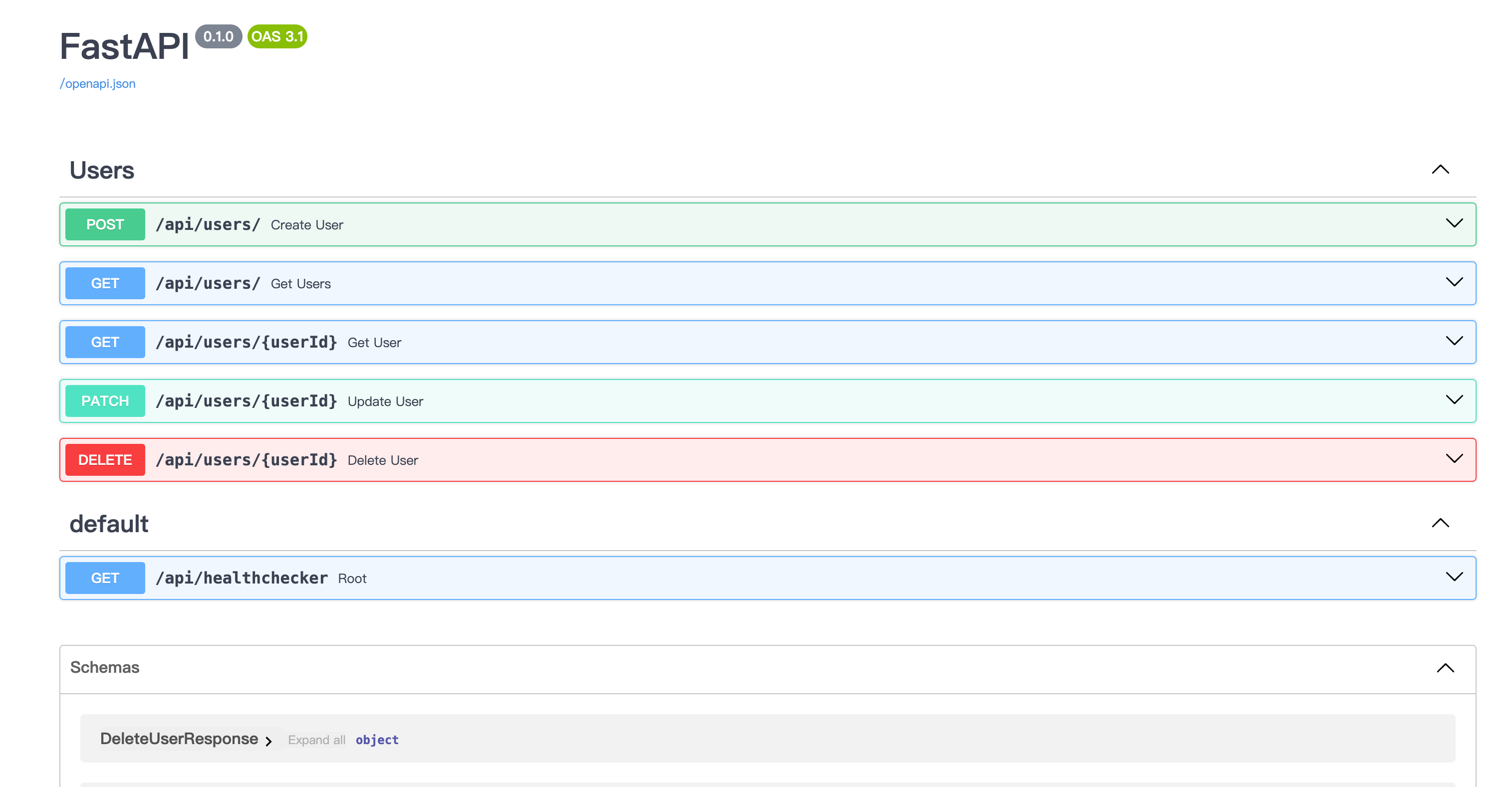
通过使用不同接口完成测试。
pytest测试
conftest
tests使用conftest.py完成封装,使用test_curd_api完成业务测试。在conftest.py中
#!/usr/bin/env python
# -*- coding: utf-8 -*-
# This module is ***
# @Time : 2024/6/6 09:54
# @Author :
# function :
# @File : conftest.py
import pytest
import uuid
from sqlalchemy import create_engine
from sqlalchemy.orm import sessionmaker
from sqlalchemy.pool import StaticPool
from fastapi.testclient import TestClient
from app.main import app
from app.database import Base, get_db
# SQLite database URL for testing
SQLITE_DATABASE_URL = "sqlite:///./test_db.db"
# Create a SQLAlchemy engine
engine = create_engine(
SQLITE_DATABASE_URL,
connect_args={"check_same_thread": False},
poolclass=StaticPool,
)
# Create a sessionmaker to manage sessions
TestingSessionLocal = sessionmaker(autocommit=False, autoflush=False, bind=engine)
# Create tables in the database
Base.metadata.create_all(bind=engine)
@pytest.fixture(scope="function")
def db_session():
"""Create a new database session with a rollback at the end of the test."""
connection = engine.connect()
transaction = connection.begin()
session = TestingSessionLocal(bind=connection)
yield session
session.close()
transaction.rollback()
connection.close()
@pytest.fixture(scope="function")
def test_client(db_session):
"""Create a test client that uses the override_get_db fixture to return a session."""
def override_get_db():
try:
yield db_session
finally:
db_session.close()
app.dependency_overrides[get_db] = override_get_db
with TestClient(app) as test_client:
yield test_client
# Fixture to generate a random user id
@pytest.fixture()
def user_id() -> uuid.UUID:
"""Generate a random user id."""
return str(uuid.uuid4())
# Fixture to generate a user payload
@pytest.fixture()
def user_payload(user_id):
"""Generate a user payload."""
return {
"id": user_id,
"first_name": "John",
"last_name": "Doe",
"address": "123 Farmville",
}
@pytest.fixture()
def user_payload_updated(user_id):
"""Generate an updated user payload."""
return {
"first_name": "Jane",
"last_name": "Doe",
"address": "321 Farmville",
"activated": True,
}
测试用例
接着进行测试用例的编写
tests/test_crud_api.py
#!/usr/bin/env python
# -*- coding: utf-8 -*-
# This module is ***
# @Time : 2024/6/6 09:55
# @Author :
# function :
# @File : test_curd_api.py
import time
import allure
def test_root(test_client):
response = test_client.get("/api/healthchecker")
assert response.status_code == 200
assert response.json() == {"message": "The API is LIVE!!"}
def test_create_get_user(test_client, user_payload):
response = test_client.post("/api/users/", json=user_payload)
response_json = response.json()
assert response.status_code == 201
# Get the created user
response = test_client.get(f"/api/users/{user_payload['id']}")
assert response.status_code == 200
response_json = response.json()
assert response_json["Status"] == "Success"
assert response_json["User"]["id"] == user_payload["id"]
assert response_json["User"]["address"] == "123 Farmville"
assert response_json["User"]["first_name"] == "John"
assert response_json["User"]["last_name"] == "Doe"
def test_create_update_user(test_client, user_payload, user_payload_updated):
response = test_client.post("/api/users/", json=user_payload)
response_json = response.json()
assert response.status_code == 201
# Update the created user
time.sleep(
1
) # Sleep for 1 second to ensure updatedAt is different (datetime precision is low in SQLite)
response = test_client.patch(
f"/api/users/{user_payload['id']}", json=user_payload_updated
)
response_json = response.json()
assert response.status_code == 202
assert response_json["Status"] == "Success"
assert response_json["User"]["id"] == user_payload["id"]
assert response_json["User"]["address"] == "321 Farmville"
assert response_json["User"]["first_name"] == "Jane"
assert response_json["User"]["last_name"] == "Doe"
assert response_json["User"]["activated"] is True
assert (
response_json["User"]["updatedAt"] is not None
and response_json["User"]["updatedAt"] > response_json["User"]["createdAt"]
)
@allure.title('删除用户')
def test_create_delete_user(test_client, user_payload):
"""
:param test_client:
:param user_payload:
:return:
"""
response = test_client.post("/api/users/", json=user_payload)
response_json = response.json()
assert response.status_code == 201
# Delete the created user
response = test_client.delete(f"/api/users/{user_payload['id']}")
response_json = response.json()
assert response.status_code == 202
assert response_json["Status"] == "Success"
assert response_json["Message"] == "User deleted successfully"
# Get the deleted user
response = test_client.get(f"/api/users/{user_payload['id']}")
assert response.status_code == 404
response_json = response.json()
assert response_json["detail"] == f"No User with this id: `{user_payload['id']}` found"
def test_get_user_not_found(test_client, user_id):
response = test_client.get(f"/api/users/{user_id}")
assert response.status_code == 404
response_json = response.json()
assert response_json["detail"] == f"No User with this id: `{user_id}` found"
def test_create_user_wrong_payload(test_client):
response = test_client.post("/api/users/", json={})
assert response.status_code == 422
def test_update_user_wrong_payload(test_client, user_id, user_payload_updated):
user_payload_updated["first_name"] = (
True # first_name should be a string not a boolean
)
response = test_client.patch(f"/api/users/{user_id}", json=user_payload_updated)
assert response.status_code == 422
response_json = response.json()
assert response_json == {
"detail": [
{
"type": "string_type",
"loc": ["body", "first_name"],
"msg": "Input should be a valid string",
"input": True,
}
]
}
def test_update_user_doesnt_exist(test_client, user_id, user_payload_updated):
response = test_client.patch(f"/api/users/{user_id}", json=user_payload_updated)
assert response.status_code == 404
response_json = response.json()
assert response_json["detail"] == f"No User with this id: `{user_id}` found"
执行测试用例的时候,可以直接点击ide,这里使用的是macOs pycharm中的三角,也可以执行
pytest -s -v
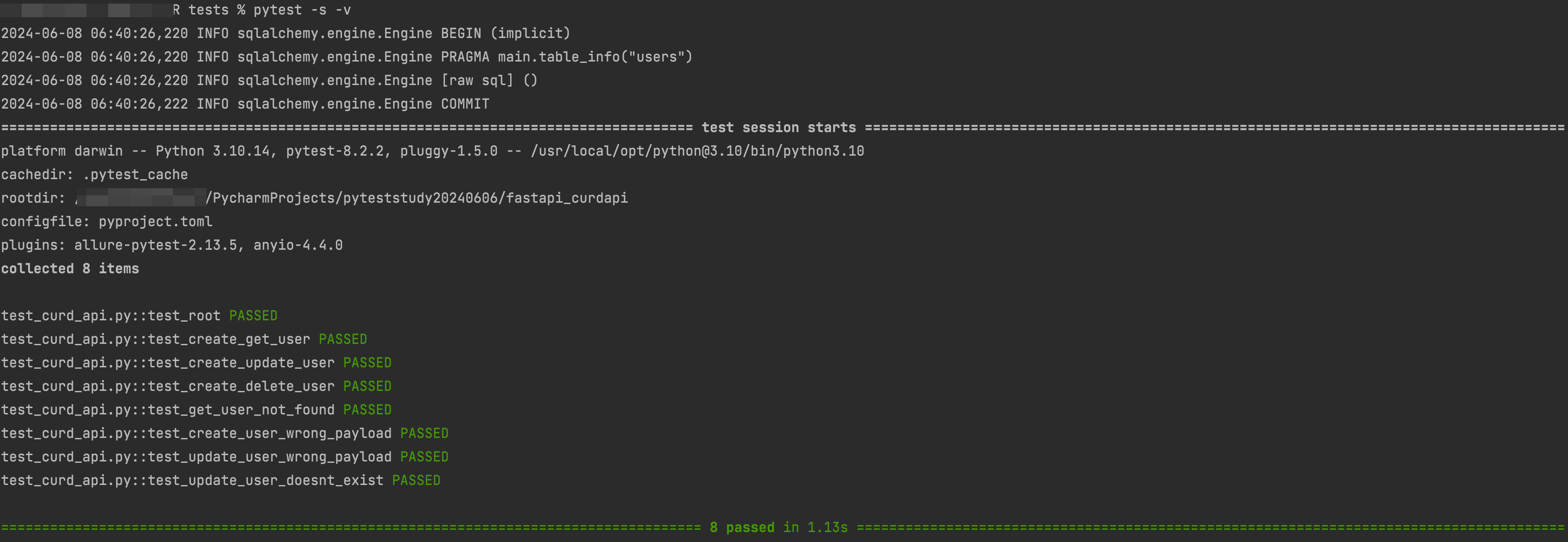
这里📢:执行中展示的是pytest 3.10.14,上文中给出的执行环境是python3.9.6,因为Python3.9.6是系统自带的python,后面自己又brew了python3的,两套环境执行均无问题,不要造成困扰,关于解释器或者是command not found的问题处理非常简单,参考F&Q的问题,找不到命令大都是PATH的路径不对,或者顺序不对,因为如果有,查找PATH的时候是从前往后的查找,顺着这个思路排查.如果使用觉得要pip3麻烦,可以在pip的对应bin目录下,cp pip3 pip这样使用较为方便,自己搞清楚怎么折腾都可以
这里要推荐的是另一个pytest插件,pytest-sugar.
*******R tests % pip3 install pytest-sugar
Collecting pytest-sugar
Using cached pytest_sugar-1.0.0-py3-none-any.whl.metadata (4.4 kB)

测试报告
pytest本身可以直接使用pytest html,且可以做一些定制的工作,这里介绍下allure,专为测试报告而生的.
pip3 install allure-pytest
- 使用–aluredir 参数指定目录保存Allure的结果数据
pytest --alluredir=./allure-results
这将会在指定的目录(例如./allure-results)下生成Allure需要的XML报告数据文件。
2. 一旦测试运行完成并且结果数据已生成,你可以使用Allure命令行工具生成测试报告:
allure serve ./allure-results
这个命令会在本地启动一个web服务器,并自动打开浏览器展示报告。
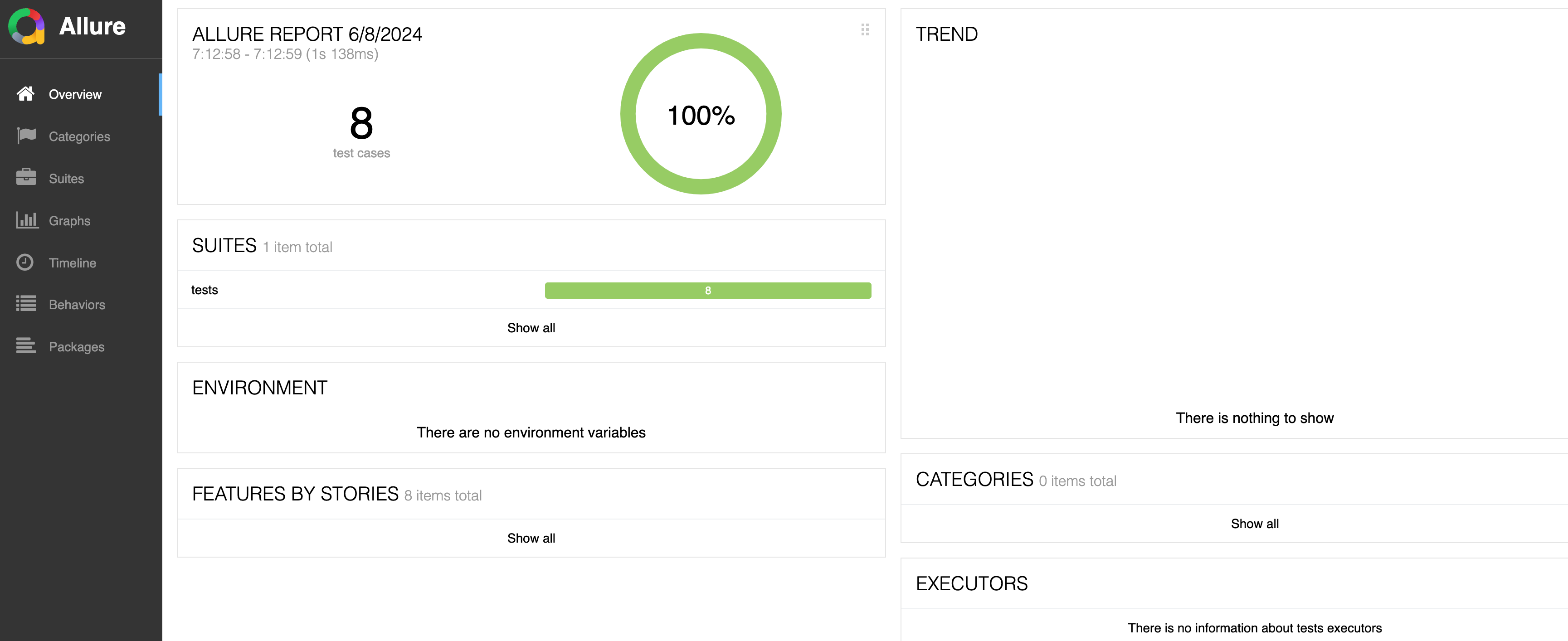
那在测试用例中删除用户的case上面给出的 title 有什么用呢,质量报告中也可以看出
@allure.title('删除用户')
def test_create_delete_user(test_client, user_payload):
...
点击上面的 【SUITES】跳转进入到下面的执行用例详情
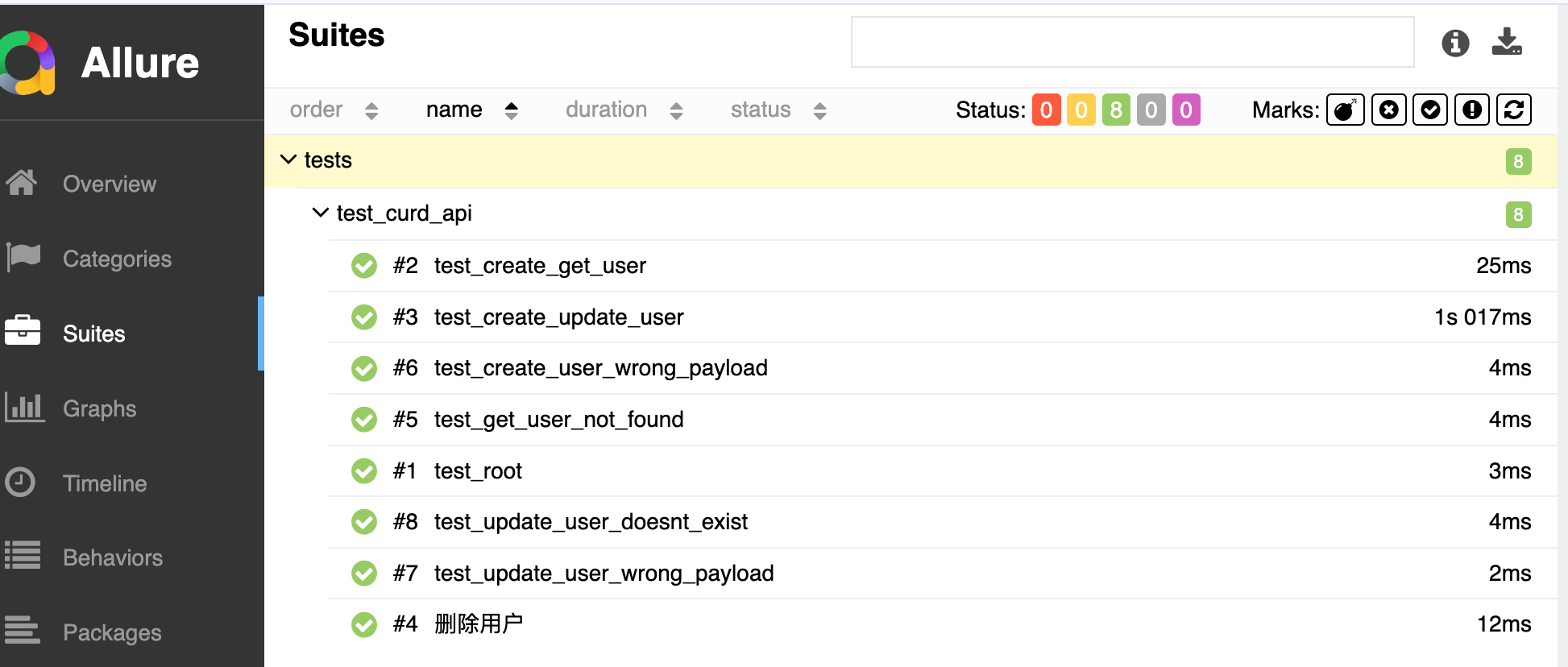
- 如果你想直接生成静态HTML报告到特定目录,可以使用:
allure generate ./allure-results -o ./allure-report --clean
其中,-o 后面跟的是输出目录,--clean选项会在生成报告前清空输出目录.
查看报告:
如果你使用了allure serve命令,报告会立即在默认浏览器中打开。如果是通过allure generate生成的静态报告,只需在文件浏览器中打开./allure-report/index.html即可查看。
以上就是使用pytest和Allure生成测试报告的基本流程。如果你需要更复杂的配置,比如定制报告样式、集成到CI/CD流程中,或者使用Allure的更多特性,可以查阅Allure的官方文档以获取更多信息。
使用过程中经常会遇到pytest --alluredir=./allure-results 和allure generate ./allure-results
❓❓❓pytest --alluredir=./allure-results 和allure generate ./allure-results是什么区别呢?
很明显,只要携带了pytest**肯定是有执行测试的过程,加上
pytest --alluredir=path/to/directory 回收集执行测试的同事收集测试执行的相关数据(如测试用例的状态、步骤、附件信息等)并保存到指定的目录,默认是./allure-results,这个过程是Pytest执行阶段+ allure手机收集阶段
现在生成测试报告的数据准备在./allure-results中之后,使用allure的命令行工具处理数据并生成优美的测试报告,allure generate就是做这件事的
allure generate ./allure-results -o ./allure-report --clean
-o ./allure-report 指定了报告的输出目录, --clean 会先清除之前生成的报告内容,确保生成的是最新的报告
所以上面一个给allure准备数据,一个生成报告的。
❓❓❓ 那allure serve ./allure-results和allure generate ./allure-results -o ./allure-report --clean是什么区别呢?
allure serve ./allure-results不仅生成报告,还会启动一个内置的HTTP服务器,立即在默认浏览器中打开并展示生成的报告allure generate ./allure-results -o ./allure-report --clean是将allure的数据文件转为静态的离线的HTML测试报告
**allure** [options] [command] [command options]
其中commands:
generate 生成allure报告
serve 启动allure服务,打开allure报告
open 打开generate 命令生成的allure报告
F&Q
执行为macOS Sonoma 14.0 python3.9.6
# python3 -V
Python 3.9.6
1.执行uvicorn app.main:app --host localhost --port 8000 --reload 报错 zsh: /usr/local/bin/uvicorn: bad interpreter
- 查看python路径
% which python3
/usr/bin/python3
- 检修uvicorn脚本的Shebang行
which uvicorn
/Python/3.9/bin/uvicorn
既然报错解释器相关的问题,进入到文件中,将第一行解释器的路径修改为
#!/usr/bin/python3
保存退出即可。
2.生成requirement.txt时,pip3 list pipreqs有,但是执行pipreqs提示command not found
- 查询pipreqs命令
ffastapi_curdapi % which pipreqs
pipreqs not found
fastapi_curdapi % pip3 list| grep pipreqs
pipreqs 0.5.0
fastapi_curdapi % pipreqs
zsh: command not found: pipreqs
fastapi_curdapi %
bfastapi_curdapi % which python3
/usr/bin/python3
如果which中找不到,则说明不在$PATH中,这里看到Python位于/usr/bin/下,而macOS中一般客户手动安装的路径位于/usr/local/bin/下,查询pipreqs的安装路径
fastapi_curdapi % pip3 show pipreqs | grep Location
Location: ~/Library/Python/3.9/lib/python/site-packages
重点关注输出中的Location字段,它会显示该包的安装路径。全局安装的包一般位于/usr/local/lib/pythonX.Y/site-packages(X.Y代表你的Python版本),而用户级安装的包通常位于~/Library/Python/X.Y/lib/python/site-packages
在用户级目录下发现
bin % pwd
***/Library/Python/3.9/bin
bin % ls | grep pipreqs
pipreqs
需要将对应的路径添加到PATH中,添加到用户PATH中,一般有~/.bash_profile和~/.zshrc两个文件,
~/.bash_profile 和 ~/.zshrc 是两种不同Shell的配置文件,它们分别用于Bash和Zsh这两种Unix/Linux shell环境中。它们存储着用户自定义的设置和环境变量,使得用户可以在启动shell时应用自己的个性化配置。下面是两者的具体区别:
~/.bash_profile
- 用途: 主要用于Bash shell。它是Bash在登录(login)模式下读取的第一个配置文件。当用户通过终端登录或者使用ssh远程登录时,Bash会执行这个文件来设置环境变量(如PATH)、别名(aliases)以及其他一些初始化设置。
- 特点: 适合放置那些只需要在登录时执行一次的配置,比如环境变量设置、启动程序等。
- 兼容性: 由于Bash是大多数Linux发行版和macOS的默认shell,所以这个文件在这些系统中非常常见。
~/.zshrc
- 用途: 专用于Zsh shell。无论是在交互式登录还是非登录shell中,Zsh都会读取这个文件。这意味着每次你打开一个新的Zsh终端窗口或tab时,~/.zshrc中的配置都会被应用。
- 特点: 由于Zsh提供了比Bash更多的功能和定制性,~/.zshrc可以包含更复杂的配置,如插件管理(如oh-my-zsh)、主题设置、自定义函数、别名等。
- 兼容性: 自macOS Catalina开始,Apple将Zsh设为默认shell,因此在较新的macOS系统中,~/.zshrc成为用户配置shell环境的主要文件
如果你正在使用macOS并且主要使用的是Zsh(尤其是在Catalina及以后的版本),那么你应当关注/.zshrc的配置。如果你在某些场景下仍然使用Bash(或者系统默认是Bash),则需要维护/.bash_profile。两者都非常重要,因为它们决定了你的shell环境如何响应你的命令以及提供哪些功能。在一些情况下,用户可能需要在这两个文件中都做一些配置,特别是当他们同时在Bash和Zsh环境中工作时。而且macOS Catalina是Mac的第16个主要版本,版本号为macOS 10.15,从 2019.10.8 开始,所以可以认为只需要维护~/.zshrc即可。
# 使用的macos的默认python,位于/usr/bin下,而用户级一般位于/usr/local/bin下,因此需要将用户级安装目录加入到PATH中
export PATH="自己的目录地址/Library/Python/3.9/bin:$PATH"
保存退出后,执行
source ~/.zshrc
这里大家会好奇机器明明Sonoma 14.0为什么要修改 .zshrc呢,当然是确定本机的默认Shell已经从Bash是否切换到了Zsh。执行命令
% echo $SHELL
/bin/zsh
发现这里已经切换到zsh,所以上面需要修改~/.zshrc
3.pydantic_core._pydantic_core.ValidationError: 1 validation error for UserBaseSchema
在执行pytest全量的case时报错如下:
E pydantic_core._pydantic_core.ValidationError: 1 validation error for UserBaseSchema
E updatedAt
E Input should be a valid datetime [type=datetime_type, input_value=None, input_type=NoneType]
E For further information visit https://errors.pydantic.dev/2.7/v/datetime_type
../../../../Library/Python/3.9/lib/python/site-packages/pydantic/main.py:1220: ValidationError
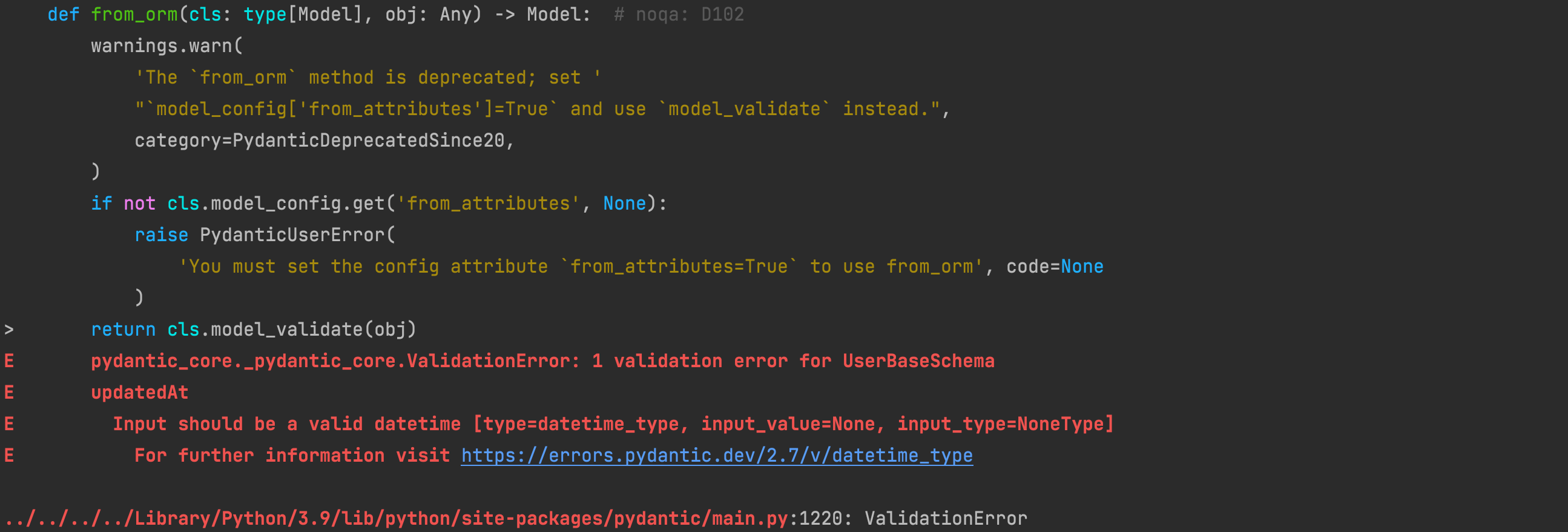
这个错误信息表明你在使用Pydantic模型(UserBaseSchema)验证数据时遇到了问题,具体来说,错误发生在updatedAt字段,它期望一个有效的datetime类型值,但实际上收到了None,所以发现在schemas.py中定义updatedAt和createdAt都使用了初始化值为None的情况
...
address: str = None
activated: bool = False
createdAt: datetime = None
# updatedAt: datetime = None
updatedAt: datetime = Field(default_factory=datetime.utcnow)
...

针对warning告警,在代码中完成更新。



